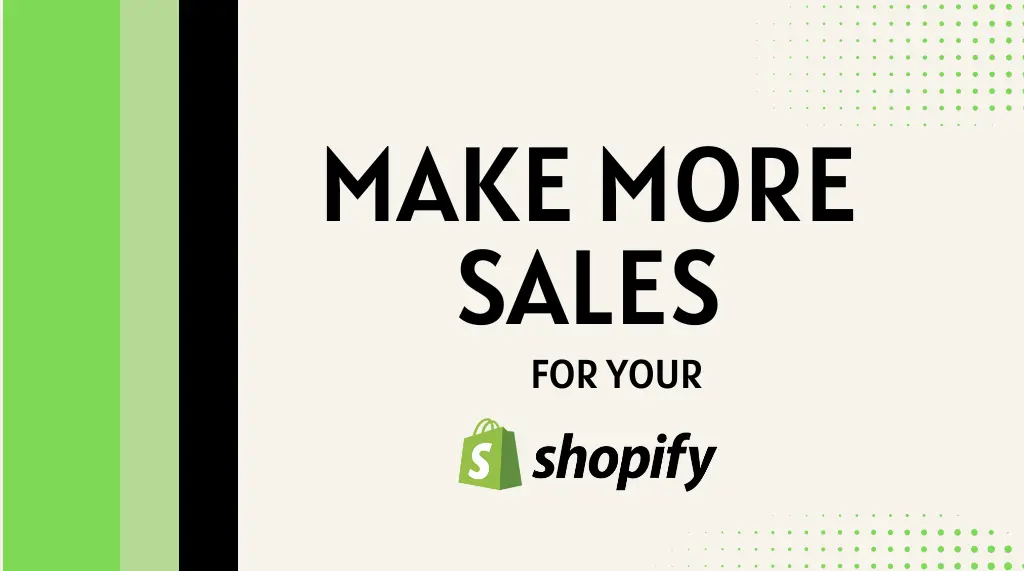Launching a Shopify store is a significant achievement, but driving sales can be challenging. If you’re wondering how to boost orders and maximize profits, you’re in the right place. This guide will walk you through actionable strategies to enhance your Shopify store’s performance.
1. Improve User Experience
Creating a positive first impression is crucial. Think of your Shopify store as a physical storefront. If a brick-and-mortar shop is disorganized, customers are likely to leave quickly. The same applies online.
Key Elements of a Great User Experience
- Hero Section: This is the first thing customers see. Make it visually appealing with high-quality images, compelling headlines, and clear call-to-actions (CTAs). Avoid overwhelming visitors with too much text.
- Navigation: Ensure your store is easy to browse. A clean, organized layout keeps visitors engaged, reduces bounce rates, and increases conversions.
- Themes: Utilize the Shopify Theme Store for customizable templates that showcase your brand effectively. Many themes are free, requiring only a Shopify plan.
2. Engage Visitors Longer
Keeping customers on your site longer increases the likelihood of a purchase. Here’s how to do it:
- Product Recommendations: Add “More Products Like This” carousels to suggest similar items. This encourages browsing, extending their time on your site.
- Incentives: If customers leave without purchasing, entice them back with offers like first-time discounts or free shipping in exchange for their email. The Shopify Forms app is an excellent tool for this.
3. Simplify the Checkout Process
A streamlined checkout process is key to reducing cart abandonment:
- Minimize Steps: Fewer steps make it easier for customers to complete their purchase.
- Payment Options: Offer multiple payment methods to cater to different preferences.
- Trust Badges: Display security badges to assure customers their information is safe.
4. Build Credibility with Reviews
Customer reviews can significantly enhance your store’s credibility and encourage sales.
Why Reviews Matter
- Trust and Confidence: Positive reviews assure potential buyers of product quality.
- Engagement: Reviews allow customers to share their experiences, creating a sense of community.
You can find numerous review apps on the Shopify App Store, which automate the process of collecting and displaying customer feedback.
Encouraging Reviews
- Incentives for Reviews: Offer rewards for leaving reviews.
- Social Media Promotion: Share top reviews on platforms like Instagram and TikTok to reach a broader audience.
5. Automate with Shopify Flow
For those on Shopify Advanced or Shopify Plus plans, the Shopify Flow app is a game-changer. It helps automate tasks, allowing you to focus on growing your business.
Features of Shopify Flow
- Workflow Automation: Use triggers, conditions, and actions to automate tasks like inventory management or fraud detection.
- Efficiency Boost: Connect different apps to streamline operations.
These strategies lay a strong foundation for increasing your Shopify sales. Stay tuned for more advanced tips to elevate your e-commerce game.
Optimizing User Experience for Maximum Engagement
In part one, we emphasized the importance of creating a visually appealing Shopify storefront. Now, let’s dive deeper into optimizing user experience to ensure that your visitors not only stay longer but also convert into paying customers.
Navigation and Load Time
One of the primary aspects of user experience is seamless navigation. Visitors should be able to find what they’re looking for quickly and without frustration. Here’s how you can enhance navigation on your Shopify store:
- Intuitive Menu Structure: Ensure your menus are well-organized and straightforward. Categorize products logically, so users can easily browse through.
- Search Functionality: Implement a robust search bar that suggests products as users type. This feature helps customers find items quickly and enhances their shopping experience.
- Fast Load Times: Speed is crucial. If your website takes too long to load, visitors are likely to leave. Use tools like Google PageSpeed Insights to analyze and improve your site’s loading time.
Mobile Responsiveness
With a significant portion of e-commerce traffic coming from mobile devices, it’s essential to have a mobile-friendly website. Shopify themes are generally responsive, but you should always test your site on various devices to ensure optimal performance. Focus on the following:
- Responsive Design: Ensure your Shopify store adjusts smoothly to different screen sizes.
- Touch-Friendly Elements: Buttons, links, and menus should be easy to tap without accidental clicks.
- Simplified Checkout: A streamlined checkout process on mobile can significantly reduce cart abandonment rates.
Customer Reviews and Testimonials
Adding customer reviews and testimonials can be a game-changer for your Shopify store. They serve as social proof and help potential buyers trust your products.
- Highlight Positive Reviews: Showcase some of the best reviews prominently on your product pages.
- Incentivize Feedback: Offer small discounts or loyalty points in exchange for customer reviews.
- Utilize AI-Driven Review Tools: Automate the process of collecting reviews by using Shopify apps that send post-purchase emails requesting feedback.
Trust Badges and Secure Payments
Another essential aspect of building trust is ensuring customers feel safe while shopping on your site. Here are a few strategies:
- Display Trust Badges: Include badges like “Secure Checkout,” “Money-Back Guarantee,” and “SSL Secured” to reassure customers.
- Offer Multiple Payment Options: Providing various payment methods such as credit cards, PayPal, and digital wallets like Apple Pay or Google Pay can increase the likelihood of conversions.
Leveraging Automation with Shopify Flow
As your business grows, managing tasks manually can become overwhelming. This is where Shopify Flow comes into play.
Automating Routine Tasks
Shopify Flow allows you to automate repetitive tasks, freeing up time to focus on strategic activities. Here’s how you can make the most of this powerful tool:
- Inventory Management: Automatically hide products that are out of stock and restock them as soon as inventory is updated.
- Order Processing: Automate workflows for order processing, fraud detection, and customer notifications to enhance efficiency.
- Customer Segmentation: Create workflows that segment customers based on their buying behavior, helping you target them with personalized marketing campaigns.
Custom Workflows
The flexibility of Shopify Flow lets you create custom workflows tailored to your business needs. Whether it’s sending automated thank-you emails after a purchase or triggering follow-up emails for abandoned carts, the possibilities are endless.
In the next section, we’ll explore how to maximize sales through strategic marketing tactics, including email marketing, social media, and retargeting. Stay tuned for actionable insights to further boost your Shopify store’s performance.
Maximizing Sales Through Strategic Marketing
In the final part of our Shopify optimization guide, we focus on driving traffic and increasing sales through effective marketing strategies. This section covers email marketing, social media engagement, and retargeting campaigns to ensure your Shopify store thrives.
Email Marketing: The Power of Direct Communication
Email marketing remains one of the most effective ways to engage with customers, build relationships, and drive repeat sales.
Building Your Email List
Start by growing a robust email list:
- Offer Incentives: Encourage sign-ups by offering discounts, exclusive content, or early access to new products.
- Pop-Ups and Sign-Up Forms: Use attractive, non-intrusive pop-ups on your site to capture email addresses.
- Segment Your Audience: Divide your list into segments based on purchase history, behavior, and demographics to send more personalized emails.
Crafting Effective Email Campaigns
Once your list is in place, focus on creating compelling email content:
- Personalized Recommendations: Use data to suggest products based on past purchases.
- Promotions and Discounts: Regularly send out exclusive offers to your email subscribers.
- Abandoned Cart Emails: Remind customers about the items they left in their cart, often including a small discount to encourage completion of the purchase.
Social Media Engagement: Building Brand Loyalty
Social media platforms are powerful tools for building brand awareness, engaging with your audience, and driving traffic to your Shopify store.
Choosing the Right Platforms
Focus on platforms where your target audience is most active:
- Instagram and Pinterest: Great for visually appealing products, especially in fashion, home décor, and beauty.
- Facebook: Offers detailed targeting options for ads and is effective for community building.
- TikTok: Ideal for reaching younger audiences with creative and engaging short-form content.
Content Strategies for Social Media
- Consistent Branding: Ensure that your visual and textual content aligns with your brand’s identity.
- User-Generated Content (UGC): Encourage customers to share photos and reviews of your products. Reposting this content builds trust and shows authenticity.
- Interactive Content: Use polls, quizzes, and live videos to increase engagement and create a sense of community around your brand.
Retargeting Campaigns: Re-Engaging Potential Customers
Retargeting is a crucial strategy for converting visitors who didn’t make a purchase on their first visit.
Setting Up Retargeting Ads
Retargeting ads work by tracking visitors and displaying ads for your products on other sites they visit:
- Facebook Pixel and Google Analytics: These tools help you track visitors and serve ads on Facebook, Instagram, and the Google Display Network.
- Dynamic Product Ads: These ads automatically show visitors products they viewed on your site, making it easier to bring them back.
Crafting Effective Retargeting Messages
- Highlight Benefits: Focus on the unique selling points of the products they viewed.
- Create Urgency: Use limited-time offers or low-stock alerts to encourage quick decisions.
- Offer Incentives: Include discounts or free shipping for returning customers to sweeten the deal.
Measuring Success and Continuous Improvement
Once your marketing strategies are in place, it’s essential to measure their effectiveness and continually refine your approach.
Key Metrics to Track
- Conversion Rate: The percentage of visitors who complete a purchase. Aim to continuously optimize your site to improve this metric.
- Average Order Value (AOV): Increase AOV by upselling and cross-selling products.
- Customer Lifetime Value (CLV): Focus on building long-term relationships with customers to increase CLV.
A/B Testing and Feedback
Regularly test different elements of your marketing campaigns:
- Email Subject Lines: See which versions get higher open rates.
- Ad Copy and Creative: Test various images, messages, and calls to action to find what resonates best with your audience.
- User Feedback: Encourage customers to provide feedback on their shopping experience to identify areas for improvement.
Conclusion
Optimizing your Shopify store is an ongoing process that involves enhancing visual appeal, streamlining user experience, and implementing effective marketing strategies. By focusing on these areas, you can create a shopping experience that not only attracts visitors but also converts them into loyal customers. Use the insights from this guide to continually refine your approach and drive your Shopify store toward long-term success.




